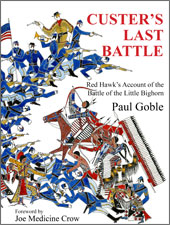| |
You can follow
Wisdom Tales Press on:
 
|
| > Children |
|
|
|
|
|
| Teens |
|
|
|
|
| Resources |
|
|
Wisdom Tales Newsletter Our periodic e-newsletters keep you up to date with our new books, special offers, etc. It is free, and easy to subscribe (or to unsubscribe): just click on the secure button below.
Recent Videos on YouTube:
We have a playlist on the World Wisdom YouTube channel, featuring Crow tribe Sun Dance Chief and Medicine Man Thomas Yellowtail.
Click here to view and play any or all of the videos with Thomas Yellowtail, on the YouTube site.
Recent Honors
NYC Big Book Awards:
• Two Winner awards for:
The Clever Wife: A Kyrgyz Folktale
• Two Distinguished Favorite Awards for:
Little Bear: An Inuit Folktale
• Two Winner Awards for:
Zen and the Ten Oxherding Pictures
Wisdom Tales
is a member of:

|
| |

Sharing the wisdom and beauty of cultures from around the world
|
|

Available Now
at your local bookseller or your favorite online book retailer. |
|
|
Custer’s Last Battle:
Red Hawk’s Account of the
Battle of the Little Bighorn |
|
Juvenile Fiction / Native American |
6 and up / Lexile measure: 940L |
Hardcover |
7.75" x 10.25" / 44 pages |
978-1-937786-11-3 |
Available now |
$16.95 |
|
| |
|
|
On the morning of June 25, 1876, a force of 700 men from the 7th US Cavalry led by General George Armstrong Custer attacked an Indian encampment on the banks of the Little Big Horn River. Unbeknownst to Custer, he faced the combined might of the Lakota, Cheyenne, and Arapaho tribes, led by many great chiefs such as Sitting Bull and Crazy Horse. Advised by his Indian scouts not to attack, the foolhardy general ignored their warnings and trusted to “Custer’s luck.”
In this commemorative edition of his first published book, Goble recounts the tale of Custer’s last battle through the eyes of Red Hawk, a fictional young Lakota warrior. Presented in the shorter format that Goble originally intended, and combined with a new author’s introduction and a foreword by Joe Medicine Crow, the Crow tribal historian whose grandfather was one of Custer’s own scouts, readers will marvel at this tale of honor and bravery.
Paul Goble (1933–2017) was an award-winning author and illustrator of over 40 children’s books. His book, The Girl Who Loved Wild Horses, won the prestigious Caldecott Medal. His most recent books are the award-winning “stories from the tipi” series, which includes The Man Who Dreamed of Elk-Dogs, The Boy and His Mud Horses, and The Woman Who Lived with Wolves.
Paul Goble lived with his wife in Rapid City, South Dakota. |
|
|
|
- Gold Medal winner of the 2014 Benjamin Franklin Award in the category “Young Reader: Fiction (8-12 Years)”
- Winner of the Midwest Book Award Silver Medal in the category “Children’s Fiction”
- Finalist for 2013 Foreword Review “Book of the Year” Award in the category “Juvenile Fiction”
|
|
|
|
“(Gr 4-8) In this stunning new edition of Goble’s Red Hawk’s Account of Custer’s Last Battle (Univ. of Nebraska, 1969), the author has modified the text to reflect the changing opinions of the battle and the benefit of new research. Punctuated by italicized explanations, Red Hawk’s account of his encounter with General Custer and his white soldiers draws readers in and keeps a hold on them throughout the entire battle. Joe Medicine Crow’s compelling foreword gives a strong Indian perspective and lends accuracy to the many versions of the events of that day. New digitized illustrations, done in the ledger-book style that Goble has beautifully mastered, add brilliant color and detail to the compelling and riveting tale. While a work of fiction, Red Hawk’s narrative is based on the compilation of many witnesses to the battle and is told in an honest and direct voice. A refreshing update that retains its original passion and bravery.”
—School Library Journal, from a review by Carol Connor, Cincinnati Public Schools, OH
“Custer’s Last Battle is a gorgeously illustrated, fictionalized yet well-researched account of the Battle of the Little Bighorn told from the point of view of a fifteen-year-old Oglala Sioux warrior. Though brief, each of the forty-four pages is enlivened by beautifully rendered, full-color ledger-book art, with drawings presented in a relatively bloodless manner suitable for the youthful audience at which it is aimed.
“First published more than forty years ago, this new version by Wisdom Tales includes not only revised and updated text but also a brighter, more brilliant remastering of the illustrations. As author and illustrator Paul Goble says, his original art work was scanned and updated ‘in glorious digitized color.’ Goble, who has won many awards as an illustrator since the original publication, has done a masterful job of not merely copying but perhaps improving on the ‘Egyptian perspective’ of the ‘bright flat colors’ and ‘detail drawing’ style used by Native Americans in the nineteenth century. His drawings closely and faithfully mimic their own artistic depictions of the epic event and tell the story of Custer’s Last Stand so clearly and concisely that graphic novelists, filmmakers, and historians would be envious.
“The text is short and simple. While fictionalized, it is drawn from firsthand accounts of participants fighting on the bluffs overlooking the Little Big Horn River in June 1876. As Chief Joe Medicine Crow, now ninety-eight, explains in the foreword to this new edition, ‘Goble’s retelling of the Custer battle’ is not only ‘based on Indian sources. It is very accurate. So you can also learn the real story from this book.’
“That story is a lively one, with fictional narrator Red Hawk’s excited prose interspersed with italicized historical sidebars to keep the whole story, and not just his role in the key part of it, in perspective. The narrative captures the thrill and excitement of a young boy in his first fight, as well as the fear and horror of hearing ‘horses and men crying out in pain’ and seeing ‘the frightened faces of babies and little children running from the soldiers’ bullets.’
“There are tales of courage on both sides. The great warrior Four Bears dies trying ‘to snatch a flag from a soldier’s hands’ and men are ‘fighting with knives and tomahawks and empty guns for clubs.’ Although told by the victor, the story does not denigrate the defeated. The author quotes the Indians’ commander, Chief Sitting Bull: ‘I will tell no lies about dead men. Those men who came with Long Hair were as good men as ever fought.’
“Custer himself, the infamous Long Hair of the tale, gets off much easier than in most modern accounts of the battle. Although no longer the unsullied martyred hero of Western lore or Hollywood, the famed general (reduced in rank to colonel after the Civil War) comes across as courageous, if not overly bold to the point of foolhardiness. For that failing, Custer and the five companies of his regiment who followed him into action that day paid the ultimate price.
“Although aimed at a young market, and described by the publisher as suitable for children as young as six, Custer’s Last Battle is a must for collectors or interested readers of books.”
—ForeWord Reviews, from a review by Mark McLaughlin
|
|
|
|
by Joe Medicine Crow
“I am now 98 years of age, so I was alive to meet many survivors of the Custer battle. I talked directly with the Cheyenne, Arapaho, Sioux, and the Crow scouts who were at the battle. My grandfather, White Man Runs Him, was a Custer scout at the battle. His Crow name really means “Chased by a White Man,” given to him because the soldiers never caught him. The Indian scouts warned Custer of the danger but he ignored them and attacked the Sioux-Cheyenne camp.
“Custer came to fight and try to end the Indian way of life. The Sioux condemned Custer for invading their country, so we say that they “Siouxed him” for it. It’s funny, yes? Custer and his men got Siouxed.
“There are over 3,000 publications about the Custer battle. But most of them ignore the accounts of the only survivors of the battle. The Indians knew the story, but most historians don’t want to listen to them. My people did not depend on writing, so they had very good memories of events. Everyone should know the true story of the battle, so I wrote a reenactment in the form of a pageant: “Battle of the Little Bighorn Reenactment”. It is historically accurate.
“The Little Bighorn Reenactment is held every year on the third week of June. Hundreds of people participate on horseback to recreate the battle, including many Crow Indians. It is exciting to watch. The Reenactment is located just south of Crow Agency, Montana. It is between the historic places of Custer’s Last Stand Hill and Reno-Benteen Battlefield.
“Paul Goble’s retelling of the Custer battle is also based on Indian sources. It is very accurate. So you can also learn the real story from this book.
“Paul Goble is a good friend. I have known him for many years. He sure can draw! His paintings are accurate in all the details. They bring the story of the Custer battle to life.”
|
|
|
|
|
|
|
|
|
|
|
|
|
|
Copyright © 2012 World Wisdom, Inc.
|
|
|
|
|